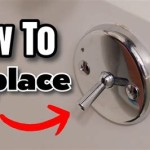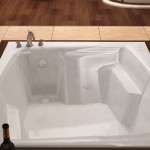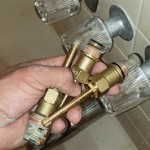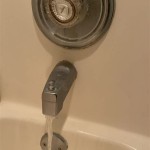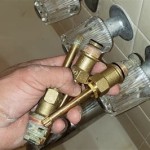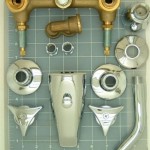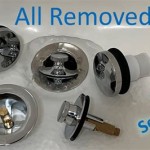How To Clean the Jets In a Whirlpool Bathtub
Whirlpool bathtubs offer a relaxing and therapeutic experience. However, maintaining them requires regular cleaning, particularly of the jets, to prevent the build-up of soap scum, oils, hair, and other debris. Neglecting this aspect of cleaning can lead to unsanitary conditions, reduced jet performance, and potential damage to the bathtub's plumbing system. This article provides a comprehensive guide on how to effectively clean the jets in a whirlpool bathtub.
Understanding Whirlpool Jet Systems
The effectiveness of cleaning whirlpool jets hinges on understanding their basic function. Most whirlpool bathtubs operate by drawing water into a pump, which then forces the water out through the jets. This process creates the massaging effect. The jets themselves are often designed with small openings and intricate pathways. These intricate designs are susceptible to clogging, particularly due to the accumulation of bath products and organic matter. Regular cleaning prevents the formation of stubborn blockages that can be difficult to remove later.
Furthermore, the warm, moist environment within the jet system is conducive to bacterial and mold growth. These microorganisms can thrive within the piping, creating biofilms that are resistant to simple surface cleaning. Specialized cleaning agents and techniques are required to effectively eliminate these biofilms and maintain a sanitary bathing environment.
The frequency of cleaning depends on the frequency of use and the types of bath products used. Individuals who use their whirlpool bathtub frequently, or those who use bath oils, salts, or bubble baths, will need to clean the jets more often than those who use them less frequently or use only mild soaps.
Essential Materials and Tools
Before beginning the cleaning process, it's important to gather the necessary materials and tools. These include:
Whirlpool Bathtub Cleaner:
Specifically designed whirlpool bathtub cleaners are the most effective at breaking down soap scum, oils, and biofilms without damaging the bathtub's finish or internal components. It is crucial to look for products labeled as safe for whirlpool bathtubs.Dish Soap (Optional):
A mild dish soap can be used as a supplement to the main cleaner, especially for routine maintenance. However, it should be used sparingly to avoid excessive sudsing.White Vinegar:
White vinegar is a natural cleaning agent that can help dissolve mineral deposits and disinfect the jets. It is a good alternative for those who prefer to avoid harsh chemicals.Soft Cloth or Sponge:
A soft cloth or sponge is needed for wiping down the bathtub surface and jets. Avoid using abrasive materials that can scratch the finish.Old Toothbrush:
An old toothbrush is useful for scrubbing around the jets and removing stubborn debris.Measuring Cup:
A measuring cup is needed for accurately measuring the cleaning solution.Water:
Clean, hot water is essential for flushing the jets and rinsing the bathtub.Gloves (Optional):
Gloves can protect hands from cleaning solutions.
Step-by-Step Cleaning Instructions
The following steps outline the process for cleaning the jets in a whirlpool bathtub:
Preparation:
Begin by removing any loose debris from the bathtub. This includes hair, bath toys, or any other items that may be present. Close the drain stopper.Filling the Bathtub:
Fill the bathtub with hot water, ensuring the water level is at least a few inches above the highest jets. The water should be hot enough to effectively dissolve soap scum and oils, but not so hot that it poses a safety risk.Adding the Cleaning Solution:
Add the chosen cleaning solution to the water. If using a commercial whirlpool bathtub cleaner, follow the manufacturer's instructions for the correct amount. Typically, this involves adding a specific amount of liquid cleaner per gallon of water. If using white vinegar, add approximately one to two cups to the water. If using dish soap, add only a small amount (approximately one tablespoon) to avoid excessive sudsing.Running the Jets:
Turn on the whirlpool jets and allow them to run for 10-15 minutes. This allows the cleaning solution to circulate through the entire jet system, loosening and dissolving accumulated debris. Observe the water for any visible signs of dirt or scum being expelled from the jets.Draining the Bathtub:
Turn off the jets and drain the bathtub. As the water drains, observe whether any lingering particles are flushed out.Rinsing the Jets:
Refill the bathtub with cold water, again ensuring that the water level is above the highest jets. Run the jets again for 5-10 minutes to thoroughly rinse the system and remove any remaining cleaning solution or debris.Draining and Wiping Down:
Drain the bathtub completely. Use a soft cloth or sponge to wipe down the bathtub surface and jets, removing any remaining residue. An old toothbrush can be used to scrub around the jets and remove any stubborn debris.Drying:
Thoroughly dry the bathtub and jets with a clean towel. This helps prevent water spots and mildew growth.
Addressing Specific Cleaning Challenges
Some situations may require specific approaches to ensure thorough cleaning:
Stubborn Clogs:
If the jets are partially or completely clogged, a more aggressive cleaning approach may be necessary. This can involve using a specialized jet cleaner or attempting to manually dislodge the clog with a thin, flexible tool, such as a pipe cleaner or wire. Exercise caution when using such tools to avoid damaging the jets.Mold and Mildew:
If mold or mildew is present, a stronger disinfectant may be required. A solution of bleach and water (1 part bleach to 10 parts water) can be effective, but it is essential to test the solution on an inconspicuous area of the bathtub first to ensure it does not damage the finish. Ensure adequate ventilation when using bleach.Hard Water Deposits:
Hard water can leave behind mineral deposits that can clog the jets and reduce their performance. White vinegar is an effective natural solution for dissolving these deposits. For stubborn deposits, a commercial hard water stain remover may be necessary.
Preventative Maintenance
Preventative maintenance is key to minimizing the need for intensive cleaning and prolonging the life of the whirlpool bathtub. Implementing these preventative measures will significantly reduce the build-up of debris and the growth of microorganisms within the jet system.
Rinse the bathtub after each use to remove any lingering soap scum or bath products. This simple step can significantly reduce the build-up of debris.
Avoid using bath products that are known to produce excessive suds or leave behind residues. Opt for bath products specifically designed for use in whirlpool bathtubs. Consider using bath oils and salts sparingly, as these tend to contribute to the build-up of oily residues within the jet system.
Install a hair catcher in the drain to prevent hair from entering the plumbing system and clogging the jets. Clean the hair catcher regularly.
Regularly clean the filter, if the whirlpool bathtub has one. A clean filter ensures that the water is free of debris before it enters the jet system.
Periodically flush the jets with hot water after each use. This helps to remove any loose debris and prevent it from solidifying within the system.
By adhering to a consistent cleaning schedule and implementing preventative measures, individuals can ensure that their whirlpool bathtub remains clean, sanitary, and enjoyable for years to come. Neglecting this maintenance can result in costly repairs and a less than optimal bathing experience.

How To Clean Your Jetted Whirlpool Tub Get The Mold Out

Easy Diy How To Clean Whirlpool Tub Jets Don T Look Under The Rug With Amy Bates

How To Clean Your Jetted Tub

How To Clean A Whirlpool Tub Or Hot Sondra Lyn At Home

Cool Your Jets Jetted Tub Cleaning House Work

How To Clean A Jetted Tub No More Gunk In The Water Bob Vila

Whirlpool Maintenance

How To Clean Your Jetted Tub

How To Remove Clean Jets From Jetted Tub Lasco Aquatic

How To Clean Your Hot Tub Jets From Sunny S Pools More

